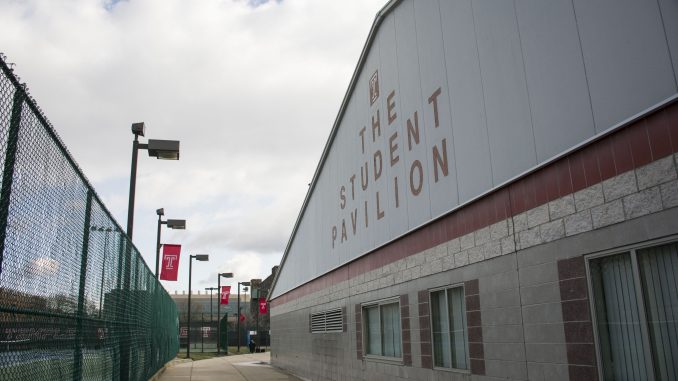
With 55 varsity and club sports on Main Campus, it can be challenging to find space to practice—especially in cold weather. When weather prevents club athletes from using outdoor fields, like The Oval and Geasey Field both located on 15th Street near Norris, they turn to indoor spaces.
These facilities, like the Student Pavilion on the corner of 15th and Berks streets and the gymnasiums in Pearson and McGonigle Halls, are limited. To get practice time in these spaces, club teams have to reach out to Peter Derstine, the assistant director of sports clubs for Campus Recreation.
It is possible that the university’s construction plans for William Penn could provide extra field space for club sports. The current plan calls for a facility for the track & field program and fields for the soccer teams,w which currently compete at Ambler.
“We set up practice spaces based on what sport they are, and what we have available,” Derstine said. “It’s a priority of who asked first, who’s in season and how much time we have.”
Michael Wellstein, captain and recruitment chair of the men’s rugby team, said getting indoor practice space is competitive for club teams.
“I can probably think of a million times we didn’t get a space and were frustrated,” said the junior finance major.
“We requested to run stairs the other night, and when we got there everything was locked. We talked to [Campus Recreation], and I said, ‘Can we at least get into the basketball gym?’” Wellstein added. “They couldn’t give us that. I had to call practice and just did weights at IBC.”
“We reached out about getting indoor space one or two nights a week, and the response was just, ‘No,’” said Amelia Schunder, a junior secondary English education major and president of the club field hockey team.
Though the Temple University Fitness Center and the IBC Student Recreation Center are open for student use, Caroline Erkes, a junior nursing major and treasurer of the field hockey team, said holding practice in a public gym with more than 30 teammates just isn’t realistic—there isn’t enough space.
Students aren’t technically allowed to hold team practices in TUF or IBC anyway and can face disciplinary action for doing so.
“There have also been occasions where [Campus] Recreation hasn’t been there to unlock the pavilion,” said Alex Barday, a senior finance major and treasurer of the wrestling team. “We practiced in the IBC instead, and got a citation because of it.”
The lack of space can be difficult for club teams who are in season and actively competing. Mike Walsh, a junior accounting major and the president of the club wrestling team, said he competed against students at nationals last week who said they were practicing five to six times a week.
“It’s pretty difficult to compete when you only practice three days a week,” Barday added.
“It’s good that we’re getting more club sports,” Wellstein said. “But the problem is that there’s only a set number of facilities and times we can use them. When you add more clubs, funding and facilities don’t increase.”
Even though club athletes are frustrated, some have said they believe that the coordinators at Campus Recreation have improved and are doing the best they can with limited space. In the past, communication was difficult between coordinators and athletes.
“You’d message a coordinator at 10 a.m., and they wouldn’t get back to you until 6:30 p.m,” said Ryan Coughlan, a senior environmental studies major and two-year captain and president of the men’s ultimate frisbee club. “They’re getting better about that.”
“How many indoor facilities can you build on a city campus?” said Terrence Malloy, a senior criminal justice major and the two-year co-captain and president of the lacrosse club. “We’re very fair, we get it.”
Though club athletes are often disappointed by the challenges of practicing inside, Wellstein said spending so much time inside builds team chemistry and excites athletes to get back outside.
“Farmers in the winter keep the cattle cooped up because they can’t run around in snow, and when the cows are let out for the first time in the spring, they freak out and prance around and roll in the grass,” Wellstein said. “It’s just like that with full grown men.”
Tsipora Hacker can be reached at tsipora.hacker@temple.edu.
Editor’s note: Michaela Winberg, the Lifestyle Editor, plays on the women’s ultimate frisbee club. She didn’t play a role in the reporting of this story.


Be the first to comment